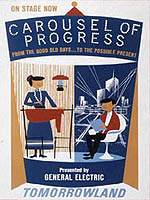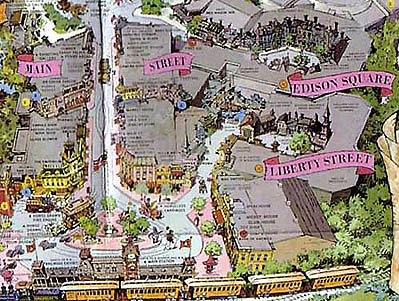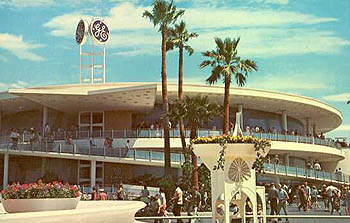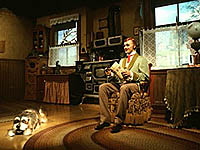 There’s a subject that has been a steady source of discussion on Disney fan forums for at least a decade now – what is going to happen to the Carousel of Progress? This attraction, one of Walt’s own, now exists only at Walt Disney World in Orlando and, at least seemingly, has teetered on the verge of extinction for years. So let’s take a step back and look at the problem that has kept old-school Disney fans on edge for all this time. What is going to happen to the Carousel of Progress? And more importantly, what should happen to this legendary attraction?
There’s a subject that has been a steady source of discussion on Disney fan forums for at least a decade now – what is going to happen to the Carousel of Progress? This attraction, one of Walt’s own, now exists only at Walt Disney World in Orlando and, at least seemingly, has teetered on the verge of extinction for years. So let’s take a step back and look at the problem that has kept old-school Disney fans on edge for all this time. What is going to happen to the Carousel of Progress? And more importantly, what should happen to this legendary attraction?
The Carousel of Progress is a theatrical attraction with an audio-animatronic cast that performs a show in four acts. The show depicts the effects that technological improvements, especially in the field of electric appliances, had upon families in the 20th century. The acts, which take place in the 1900s, 1920s, 1940s, and 2000s, are presented on separate sets built around a central hub. The audience, seated in rows radiating out from the hub, are on the actual “carousel” – the circular outer ring of the building that rotates between acts. Thus there are always six auditoriums circling the theater at once – one in the process of loading, one unloading, and four viewing actual show scenes.

The attraction has a storied past. Its origins lie in some of Walt’s original plans for expanding Disneyland, which would include two expansions – International Street and Edison Square. Edison Square, nestled between Main Street and Tomorrowland, would feature a show that was the direct thematic predecessor to the Carousel of Progress. In the preshow, guests would view a series of dioramas depicting scenes from the life of Thomas Edison and culminating in his creation of the incandescent light bulb. They would then proceed to the main show which, like the Carousel of Progress, took place in four acts. The difference in this Ur-Carousel was that instead of taking place in a carousel theater, guests would get up and move to a new auditorium and set for each new scene. The show scenes themselves, hosted by ‘electro-mechanical’ performer Wilbur K. Watt, followed a similar temporal and thematic progress to the later Carousel show. With a post-show consisting of a product showroom, the attraction appealed to potential sponsor General Electric, but at the time – the mid to late 1950s – animatronic technology had not progressed to the point that Walt felt comfortable using it on such a scale.

 This would change with several developments in the early 1960s, and the coming of the 1964-65 World’s Fair. Disney’s involvement with the New York fair is well-known, but I think it’s often overlooked as to what a stroke of genius it actually was. In one fell swoop, Disney spread brand awareness in a massive way, did a great deal of stealthy market research for his “east coast Disneyland”, persuaded major corporations to underwrite huge advances in ride and show technology through the attractions he developed for them, and essentially convinced these corporations to pay for these attractions which he then relocated to Disneyland after the fair. One of these attractions, the centerpiece of General Electric’s Progressland, was the Carousel of Progress. Similar in feel and presentation to the current Carousel, the show took advantage of several key advances in Audio-Animatronics that had been developed for The Enchanted Tiki Room in 1963 and the World’s Fair attraction Great Moments with Mr. Lincoln. When the fair ended, the Carousel of Progress was moved to Disneyland; there, it received a new, more contemporary finale scene and became part of the massive 1967 Tomorrowland remodel.
This would change with several developments in the early 1960s, and the coming of the 1964-65 World’s Fair. Disney’s involvement with the New York fair is well-known, but I think it’s often overlooked as to what a stroke of genius it actually was. In one fell swoop, Disney spread brand awareness in a massive way, did a great deal of stealthy market research for his “east coast Disneyland”, persuaded major corporations to underwrite huge advances in ride and show technology through the attractions he developed for them, and essentially convinced these corporations to pay for these attractions which he then relocated to Disneyland after the fair. One of these attractions, the centerpiece of General Electric’s Progressland, was the Carousel of Progress. Similar in feel and presentation to the current Carousel, the show took advantage of several key advances in Audio-Animatronics that had been developed for The Enchanted Tiki Room in 1963 and the World’s Fair attraction Great Moments with Mr. Lincoln. When the fair ended, the Carousel of Progress was moved to Disneyland; there, it received a new, more contemporary finale scene and became part of the massive 1967 Tomorrowland remodel.
 The Carousel of Progress at Disneyland
The Carousel of Progress at Disneyland
The show remained in place at Disneyland until 1973 when, at the behest of sponsor G.E., it was closed and relocated to the new Walt Disney World Tomorrowland in Florida. When that iteration of the attraction opened in 1975, it featured another new and location-specific finale. An entirely different narration, replacing Rex Allen’s original voice-over from the World’s Fair, was recorded by character actor Andrew Duggan. The show also featured a new theme song by the Sherman Brothers; their original track from the Disney land show, the optimistic “There’s A Great Big Beautiful Tomorrow”, was replaced by the more pragmatic “The Best Time Of Your Life” (commonly known as “Now Is The Time”).
 The “future of the 1970s” gave way to the “future of the 1980s” when yet another new final scene was scripted in 1981. In 1985, General Electric’s sponsorship contract expired and they elected not to renew. A small change in the show’s audio track served to remove mention of the company’s brand name from all those snazzy appliances in our protagonist’s kitchen. The greatest change in Walt Disney World’s version of the Carousel came in 1994, when as part of the Tomorrowland facelift the show was entirely re-recorded and renamed Walt Disney’s Carousel of Progress.
The “future of the 1970s” gave way to the “future of the 1980s” when yet another new final scene was scripted in 1981. In 1985, General Electric’s sponsorship contract expired and they elected not to renew. A small change in the show’s audio track served to remove mention of the company’s brand name from all those snazzy appliances in our protagonist’s kitchen. The greatest change in Walt Disney World’s version of the Carousel came in 1994, when as part of the Tomorrowland facelift the show was entirely re-recorded and renamed Walt Disney’s Carousel of Progress.
 The new show featured many changes, most notably a new narration recorded by humorist Jean Shepherd – best known for writing and narrating the film A Christmas Story. Characters – and pets – were re-named, holiday themes were added each scene, and yet another ‘futuristic’ finale served to take viewers into the 21st century. The show was framed as a tribute to Walt, with an introduction explaining his attachment to the attraction and the significance of its debut at the 1964 World’s Fair. Televisions were added to the outside queue featuring scenes from the Wonderful World of Color episode Disneyland Goes To The World’s Fair, in which Walt takes a look at the show’s creation and discusses its theme song with the Sherman Brothers.
The new show featured many changes, most notably a new narration recorded by humorist Jean Shepherd – best known for writing and narrating the film A Christmas Story. Characters – and pets – were re-named, holiday themes were added each scene, and yet another ‘futuristic’ finale served to take viewers into the 21st century. The show was framed as a tribute to Walt, with an introduction explaining his attachment to the attraction and the significance of its debut at the 1964 World’s Fair. Televisions were added to the outside queue featuring scenes from the Wonderful World of Color episode Disneyland Goes To The World’s Fair, in which Walt takes a look at the show’s creation and discusses its theme song with the Sherman Brothers.









Recent Comments